Please use this identifier to cite or link to this item:
http://drsr.daiict.ac.in//handle/123456789/339| Title: | Practical approach for depth estimation and image restoration using defocus cue |
| Authors: | Joshi, Manjunath V. Ranipa, Keyur R. |
| Keywords: | Imaging systems Image quality Image reconstruction Image processing Digital techniques Three-dimensional imaging Computer graphics Multimedia systems |
| Issue Date: | 2011 |
| Publisher: | Dhirubhai Ambani Institute of Information and Communication Technology |
| Citation: | Ranipa, Keyur R. (2011). Practical approach for depth estimation and image restoration using defocus cue. Dhirubhai Ambani Institute of Information and Communication Technology, viii, 44 p. (Acc.No: T00302) |
| Abstract: | Reconstruction of depth from 2D images is an important research issue in computer vision. Depth from defocus (DFD) technique uses space varying blurring of an image as a cue in reconstructing the 3D structure of a scene. In this thesis we explore the regularization based approach for simultaneous estimation of depth and image restoration from defocused observations. We are given two defocused observations of a scene that are captured with di erent camera parameters. Our method consists of two steps. First we obtain the initial estimates for the depth as well as for the focused image. In the second step we re ne the solution by using a fast optimization technique. Here we use the classic depth recovery method due to Subbarao for ob- taining the initial depth map and Wiener lter approach for initial image restoration. Since the problem we are solving is ill-posed and does not yield unique solution, it is necessary to regularize the solution by imposing additional constraint to restrict the solution space. The regularization is performed by imposing smoothness constraint only. However, for preserving the depth and image intensity discontinuities, they are indenti ed prior to the minimization process from initial estimates of the depth map and the restored image. The nal solution is obtained by using computationally e client gradient descent algorithm, thus avoiding the need for computationally taxing algorithms. The depth as well as intensity edge details of the nal solution correspond to those obtained using the initial estimates. The experimental results indicate that the quality of the restored image is found to be satisfactory even under severe space-varying blur conditions. |
| URI: | http://drsr.daiict.ac.in/handle/123456789/339 |
| Appears in Collections: | M Tech Dissertations |
Files in This Item:
| File | Description | Size | Format | |
|---|---|---|---|---|
| 200911037.pdf Restricted Access | 1.03 MB | Adobe PDF |  View/Open Request a copy |
Items in DSpace are protected by copyright, with all rights reserved, unless otherwise indicated.
